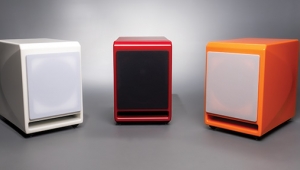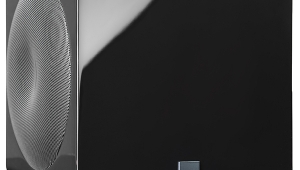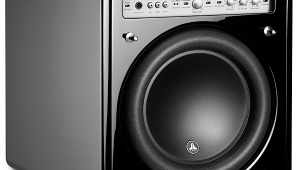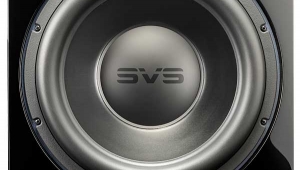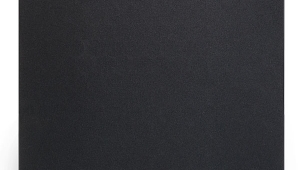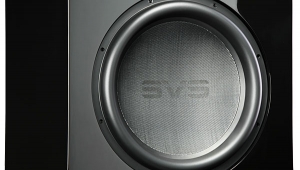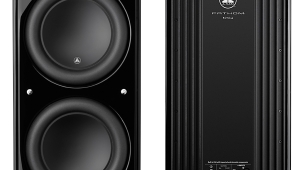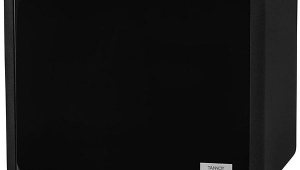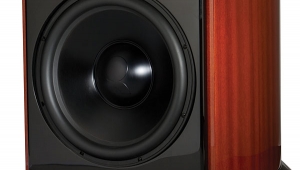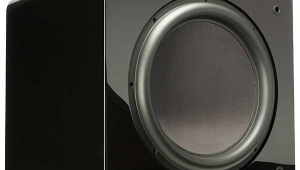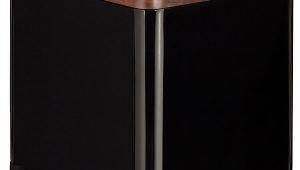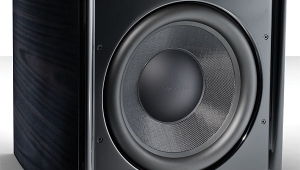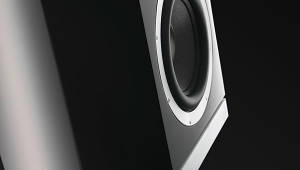| Columns Retired Columns & Blogs |
SV Sound PB13-Ultra powered subwoofer Page 2
Listening
Once correctly level-matched and equalized, the SV Sound PB13-Ultra and Quad ESL-989s generated full-range audio output with great deep-bass extension. When I played orchestral recordings, the sub rendered a clean, fast response for bass drum and timpani. The deepest notes had a tight, rhythmic quality. The PB13-Ultra's Hi Pass filter protected the Quads from the deep bass notes, allowing them to deliver greater dynamic range before their clipping protection circuits could shut them down. For example, the intense synthesizer opening of "Deeper Wells," from Emmylou Harris's Spyboy (CD, Eminent EM-25001-2), was louder than if I'd run the Quads full-range. The explosive bass impact of Mark Flynn's drums in "Blizzard Limbs," from Attention Screen's Live at Merkin Hall (CD, Stereophile STPH018-2), was fully present with the sub switched into my system.
Once correctly level-matched and equalized, the SV Sound PB13-Ultra and Quad ESL-989s generated full-range audio output with great deep-bass extension. When I played orchestral recordings, the sub rendered a clean, fast response for bass drum and timpani. The deepest notes had a tight, rhythmic quality. The PB13-Ultra's Hi Pass filter protected the Quads from the deep bass notes, allowing them to deliver greater dynamic range before their clipping protection circuits could shut them down. For example, the intense synthesizer opening of "Deeper Wells," from Emmylou Harris's Spyboy (CD, Eminent EM-25001-2), was louder than if I'd run the Quads full-range. The explosive bass impact of Mark Flynn's drums in "Blizzard Limbs," from Attention Screen's Live at Merkin Hall (CD, Stereophile STPH018-2), was fully present with the sub switched into my system.
The PB13-Ultra revealed the dense mass and solidity of synthesizer notes in film soundtracks, creating the tight, anxious mood necessary to build suspense. This was heard best with James Horner's music for Patriot Games (CD, RCA 66051-2), which mixes synthesizer pulses with chimes, gongs, and snare drums in "Attempt on the Royals." The PB13-Ultra delivered the seismic thuds of giant footsteps during "The Carnotaur Attack," from James Newton Howard's Dinosaur soundtrack (CD, Walt Disney 50086 06727); the tense, anxious, mounting, throbbing heartbeat that threads its way through Pink Floyd's "Breathe," from Dark Side of the Moon (SACD, EMI 82136-2); the pulsatile, throbbing bass notes of "First Haunting/The Swordfight," from James Horner's score for Casper (CD, MCA MCAD-11240); the synthesizer's steady drone and powerful contrabassoon in "Sand Mandala," from Philip Glass's music for Kundun (CD, Nonesuch 79460-2); the shuddering bass drum on "Silk Road," from I Ching's Of the Marsh and the Moon (CD, Chesky WO144); the raspy growl of the didgeridoo on "Rainforest Wonder," from David Hudson's Didgeridoo Spirit (CD, Indigenous Australia IA2003D); and the overblown bass line of "Ain't Yo Bidness," from Insane Clown Posse's The Wraith (CD, RIV 9912-2). The PB13-Ultra easily reproduced the sustained 25Hz synthesizer note that begins the arrangement of the Introduction of Richard Strauss's Also sprach Zarathustra on Erich Kunzel and the Cincinnati Pops' Time Warp (CD, Telarc CD-80106) with no sign of distress, and without giving any auditory clue as to its physical whereabouts.
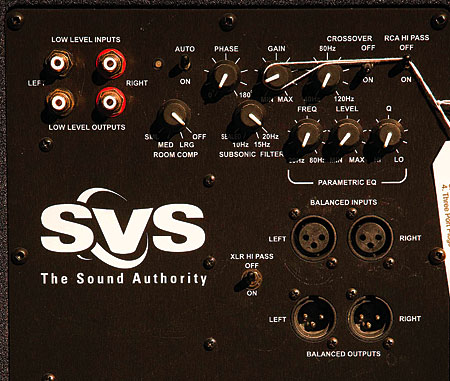
Organ recordings greatly benefited from the PB13-Ultra. The full pedal chords in the toccata that concludes Widor's Symphony 5, on Mary Preston's Organ Odyssey (CD, Reference RR-113), filled the room and rattled objects. John La Montaine's Even Song, on the same disc, ended with a powerful deep note (a 32' pipe is added on the final chord). The 32Hz pedal C that concludes Herbert Howells' Master Tallis's Testament, from Pipes Rhode Island (CD, Riago 101), was massive, solid, and authoritative. I was able to follow the different pitches of pipe-organ pedal notes played by Olivier Latry during the poco adagio of the first movement of Saint-Saëns' Symphony 3, "Organ," with Christoph Eschenbach and the Philadelphia Orchestra (CD, Ondine ODE 1094-5). Timothy Seelig and the Turtle Creek Chorale's recordings of John Rutter's Requiem, Lord, Make Me an Instrument, and A Gaelic Blessing (CD, Reference RR-57CD) were revelations: The PB13-Ultra produced clean, massive, sustained organ notes that rumbled below the three-dimensional sonic image of the chorus.
The addition of the SV Sound subwoofer did not affect the Quads' reproduction of piano music: The light, clear quality of Keith Jarrett's piano on "True Blues," from The Carnegie Hall Concert (CD, ECM 1989/90), remained. Simone Dinnerstein's recording of J.S. Bach's The Goldberg Variations (CD, Telarc CD-80692) still sounded lyrical and clean. On the other hand, when bass chords were present, as in pianist Robert Silverman's recording of Liszt's Liebestraum, on Editor's Choice (CD, Stereophile STPH016-2), the PB13-Ultra added a spacious richness to the piano's sound when played on the Quads alone.
Further listening revealed subtle differences among the PB13-Ultra and the more expensive REL Studio III, Velodyne DD-18, and JL Audio Fathom f113. A pair of Fathom f113s merged more smoothly with the Quads, producing a much deeper, more three-dimensional illusion of the soundstage than did the PB13-Ultra. The expensive REL Studio III had better pitch definition. The Velodyne DD-18—with its much larger (18") servo-controlled cone, high-pass filter, and 1400W internal amplifier—delivered greater punch, slam, and room lock. I also noticed that the PB13-Ultra added a subtle harshness and flattening of the soundstage to recordings of massed voices. This might be a function of the SVS's built-in 6dB/octave high-pass filter producing too little attenuation for the Quads' bass response. On the other hand, this same high-pass filter proved crucial for synthesizer recordings, such as the opening of "The Swordfight" from Casper: without the filter, the bass was bloated; with the filter switched on, it was tight and tuneful.
Conclusions
The SV Sound PB13-Ultra was most impressive for $1599, pumping out smooth, tuneful, distortion-free deep bass when the music called for it. Its built-in electronic crossover and single-band parametric equalizer made it as flexible as any subwoofer I've reviewed, and allowed me to quickly blend its output with that of my Quad ESL-989s to achieve clean, tight, solid bass with adequate pitch definition. The PB13-Ultra was at least half the price of, and easier to set up than, the more expensive subwoofers that have visited my listening room.
Still, the PB13-Ultra couldn't quite match the musicality of those cost-no-object subs. Some recordings revealed small amounts of bass bloat, this perhaps related to the gradual high-pass filter slopes that failed to completely suppress the Quad ESLs' low-frequency output. Additionally, the PB13-Ultra's low retail price limits what features SVS can include: it doesn't come with a remote control; or an automated, self-adjusting parametric equalizer (as used in JL Audio's Fathom f113); or the virtual spectrum analyzer found in the more expensive subwoofers. In addition, the PB13-Ultra's deep-bass output had less of the shuddering, sustained power put out by the more expensive subs.
But the SV Sound PB13-Ultra subwoofer did a remarkable job of providing great bass extension and power to my Quad ESL-989s. I heartily recommend it for its relatively low price, rugged construction, versatile controls, and sturdy drive-unit.
- Log in or register to post comments
